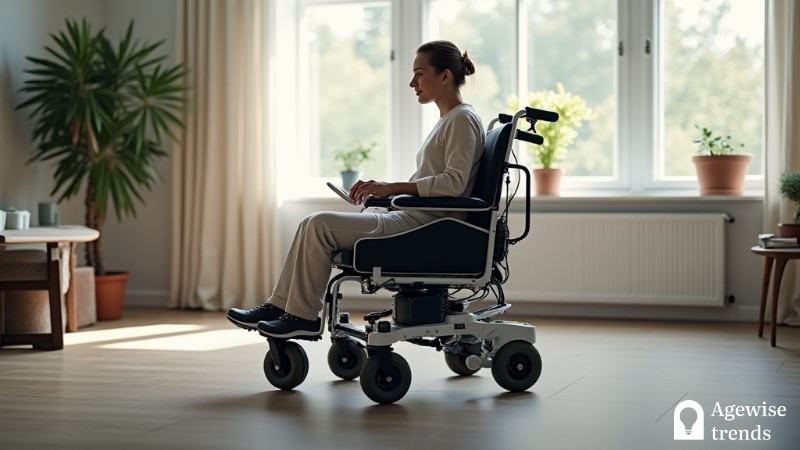The global robotic wheelchair market is poised for significant growth, driven by a rising demand for advanced mobility solutions and an aging population. From innovative AI integrations to improved sensor systems, robotic wheelchairs are revolutionizing user mobility and independence. This transformation is fueled by the need for accessible mobility devices for individuals with disabilities and post-operative mobility challenges, making robotic wheelchairs a crucial component in modern healthcare.
Key Takeaways
The global robotic wheelchair market is expected to grow significantly by 2033 due to technological advancements and an aging population.
- The market will reach $621.69 million by 2033, growing at a CAGR of 12.56%.
- Advancements in AI and sensor technology are enhancing user independence and safety.
- North America leads the market with a 32.2% share, while Asia-Pacific is expanding rapidly.
Market overview and growth forecast
The global robotic wheelchair market, estimated at US$ 241.27 million in 2024, is projected to reach US$ 621.69 million by 2033, growing at a CAGR of 12.56%. This growth is driven by the rising demand for specialized wheelchairs, with over 1.3 million people needing advanced mobility aids. By 2025, the number of wheelchair users worldwide is projected to reach 130 million, highlighting the need for more efficient solutions.
Healthcare institutions and rehabilitation centers are also contributing to market growth. In 2024, the U.S. performed over 1.54 million knee and hip surgeries, increasing the need for robotic wheelchairs. The U.S. market alone was valued at 124.2 million units in 2023, highlighting strong regional demand.
Key drivers of market growth
The growing popularity of robotic wheelchairs is largely due to advancements in AI, sensor calibration, and real-time adaptability. AI-driven autonomous navigation has significantly enhanced the functionality of these devices, improving user independence and safety. The integration of voice-activated interfaces, augmented reality, and biometric feedback systems has transformed user interaction, making these devices more intuitive and responsive to varying environments.
Technological advancements have boosted battery life to 25 miles per charge and extended robotic wheelchair lifespan to 5-7 years. With a 300-pound weight capacity and improved maneuverability, including reduced turning radii and better ground clearance, they are now more suitable for both indoor and outdoor use. These enhancements also make them compatible with senior-friendly transportation systems, expanding their utility in public and private mobility.
End-user segments and regional insights
The personal mobility segment dominated the robotic wheelchair market, holding 72% of the share in 2023. As more people adopt robotic wheelchairs for home use, residential adoption is projected to reach 1.1 million units by 2030. The retail sector also plays a significant role, with growing direct purchases through showrooms and e-commerce.
North America led the market with 32.2% share in 2023, driven by the U.S.’s aging population and strong healthcare system. Meanwhile, Asia-Pacific is expanding rapidly, with China projected to grow at a 15.2% CAGR, and the region produces over 70% of global electric wheelchairs, boosting supply and manufacturing capacity.
Technological advancements and features
The robotic wheelchair market is fueled by design and technology advancements. Mid-wheel drive models, offering better maneuverability, made up 41.2% of the revenue in 2023. Manufacturers are also focusing on creating wheelchairs that can navigate tight spaces, with average widths now reduced to 23 inches for easier access through narrow doorways.
Battery innovations are another key area of development. The average lifespan of robotic wheelchair batteries has increased to 3 years, and the time required to fully charge the battery has been reduced to 4 hours. These improvements not only enhance the user experience but also decrease the operational downtime for frequent users.
Challenges in the robotic wheelchair market
Despite advancements, challenges remain, particularly with multimodal sensor calibration. Environmental changes can cause sensor misalignments, affecting responsiveness. Manufacturers are focused on refining recalibration to improve real-time performance.
Another challenge is the high cost of these devices, which can range from $2,000 to $30,000 depending on the level of sophistication and custom features. However, as technology advances and economies of scale are achieved, the market is expected to see a reduction in costs, making robotic wheelchairs more accessible to a wider audience.
Future outlook and developments
The robotic wheelchair market is set for continued growth, with manufacturers focusing on improving battery life, energy storage, and charging times to enhance performance and convenience. Public infrastructure is evolving to support these innovations, including more wheelchair-accessible spaces and senior-friendly transportation options, further promoting mobility and independence.
As demand for mobility solutions rises and accessibility improves, the future of robotic wheelchairs looks promising, offering users greater mobility, safety, and independence through ongoing advancements and innovation.














